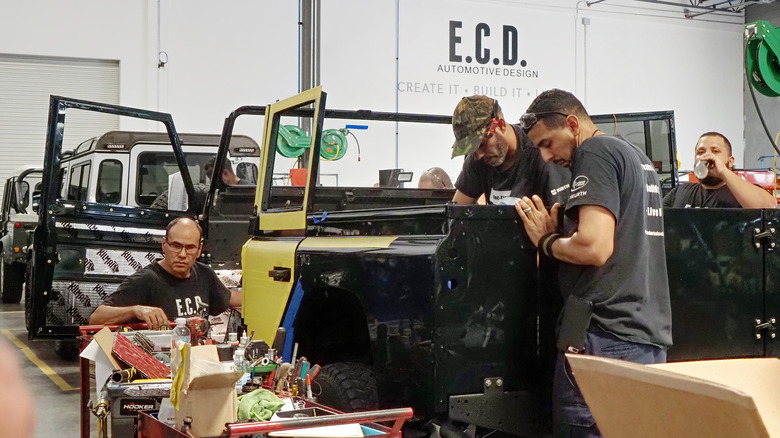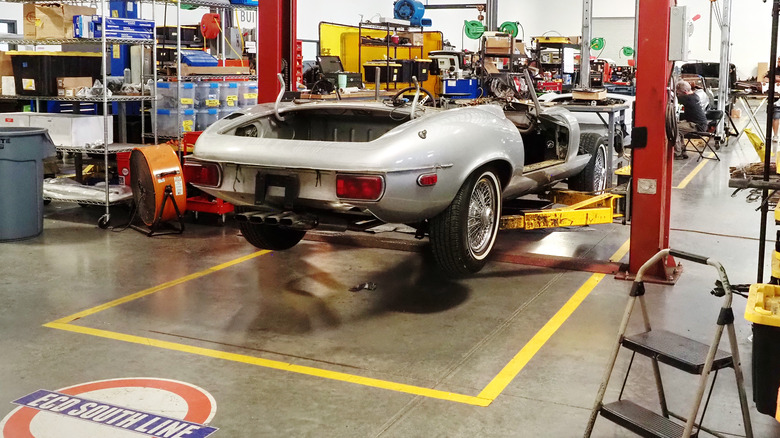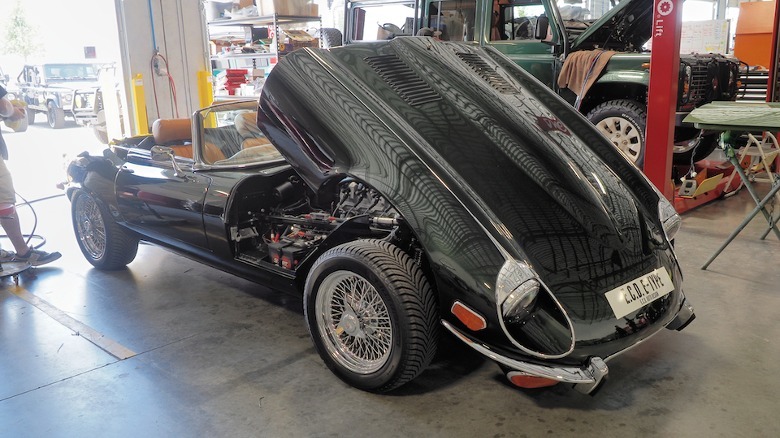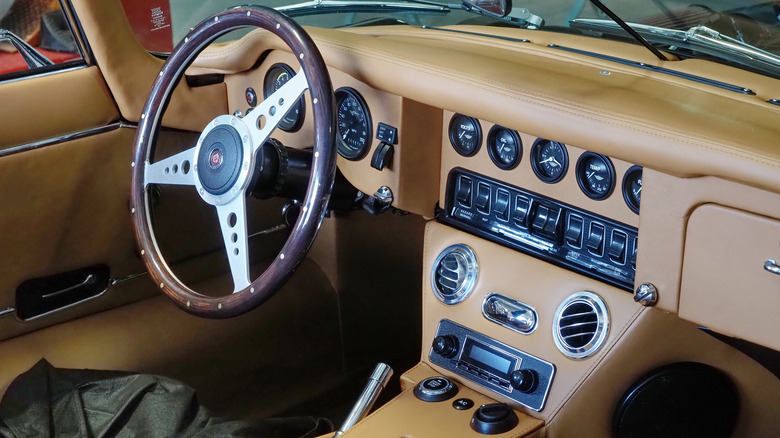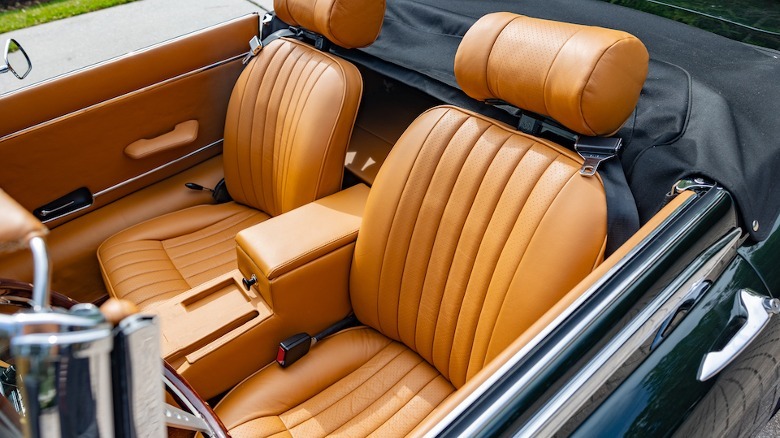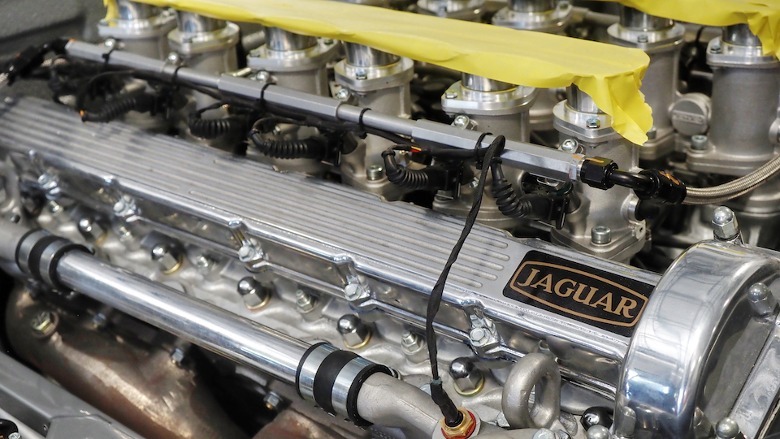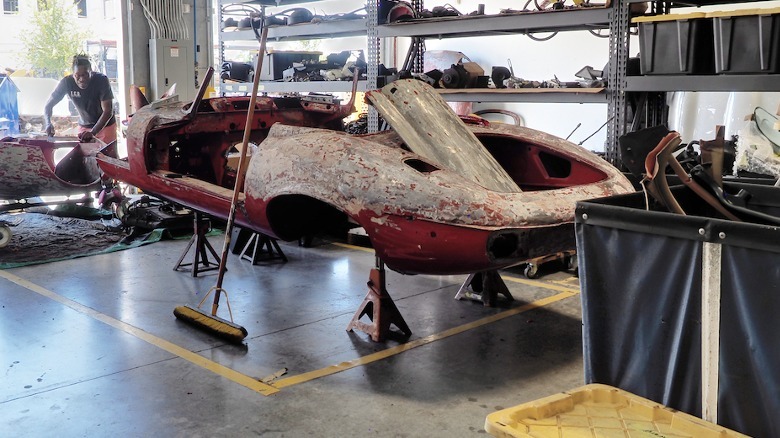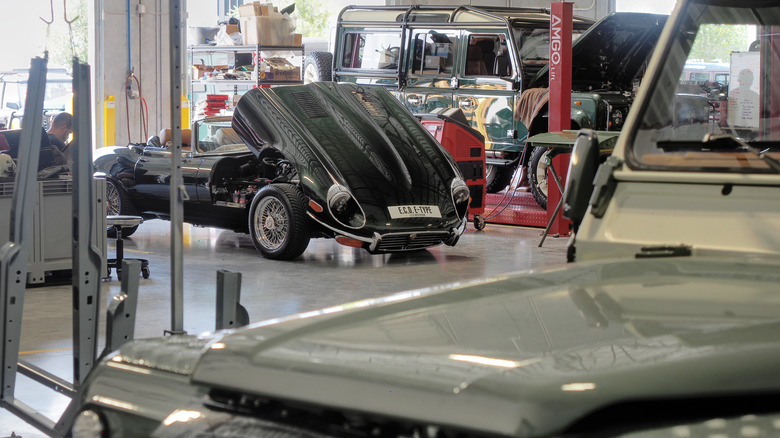Driven: This E.C.D. Jaguar E-Type With A 450hp Corvette Heart Is Sacrilege Done Right
By all rights, I should be uncomfortable. Too hot, struggling to keep up with the base-spec Hyundai Elantra in the lane alongside me, and experiencing that very specific sensation of your skeleton trying to vibrate itself apart that comes with driving a classic Land Rover Defender. Imagine my surprise, then — not to mention that of the Elantra owner — when I bury my right foot and, with a snort and rumble, the big SUV launches itself forward like a runaway steam engine with ventilated seats.
My surprise is tempered, mind, by the knowledge that this is no ordinary Defender. It's the handiwork of Florida-based E.C.D. Automotive Design, which since 2013 has been taking Land Rover's icon and giving it the sort of performance, refinement, and reliability that come with a six-figure rebuild. Gone are the rattles and rust, and in their place are more than 500 Defenders thoroughly reinvented and each entirely unique.
Now, E.C.D. is facing two huge upheavals. As I visited, the first of the company's second product series was finally rolling off the line. The E.C.D. E-Type takes the classic Jaguar sports car and, over the course of around 2,200 hours, painstakingly restores it, with a choice of an original engine, the LT1 from a modern Corvette, or (and perhaps most exciting) a fully-electric drivetrain. At the same time, E.C.D. is preparing to go public. That'll bring with it a sizable injection of cash — enough, indeed, to help kickstart a third model series — but also the pressures of investor expectations for what until now has been a privately-owned endeavor. Then again, E.C.D. is no stranger to reinvention.
Stripped to the bare bones
The process starts with a donor Defender — they built, E.C.D. CEO and co-founder Scott Wallace points out, about two million of them — which the company typically sources itself. Condition, with one key exception, isn't all that important: E.C.D. will strip it down to the frame anyway, keeping any unusual or rare extras or options, and replacing everything else. As long as it's on the original frame, though, the reborn Defender can be registered again.
E.C.D. has learned to keep quiet on just who is doing the shopping for possible candidates: if owners realize the identity of the potential buyer, Wallace says, they tend to expect higher pricing; $6,000-$7,000 seems around the sweet spot for a well-loved (read: pretty bedraggled) example.
Budget another $4k or so for arranging shipping to the U.S. — E.C.D. took that process into its own hands at the start of the pandemic, as the price of moving containers around the world ramped up exponentially — and then the fun part can begin. The E.C.D. team has dismemberment down to a fine art, with different crew members responsible for extracting reusable parts as well as refurbishing things like the original differentials.
Subtle or screaming, the choice is yours
From that point on, the magic is in the vision of the client. Some of E.C.D.'s builds are practically sleepers: conservative exteriors, restrained cabins — albeit with more leather, wood, and metal than an original Land Rover driver could ever have dreamed of — and eminently suited to daily-driver status. Only the eagle-eyed might spot the custom paintwork and accessories, the hand-trimmed interior, and of course the company's LS3 and LT1 engine swaps for when 430+ horsepower is essential.
Then there are the cars at the other extreme. Head-turning paint jobs — done in-house, in the company's own paint shop — and bodywork redesigns. Plush seating — brand-new Recaros, stripped of fabric and padding, and reworked from the frame up by E.C.D.'s own upholstery team — and monster audio systems. Want paintwork that matches your favorite purse? E.C.D. has done it already. Need nine seats and wood paneling like the deck of your yacht? No problem at all.
Whether low-profile or screaming bespoke, the design process is much the same. Part of E.C.D.'s unique charm, Wallace says, is how engrossed buyers can get in the design process: from the broad strokes of Defender body, seating, and engine, down to the minutiae of leather and other materials, hand-stitched patterns, and luxury touches no classic Defender has been treated to.
Enthusiasts become fans, fans become addicts
E.C.D., much like some other big names in giving rich people what rich people want, doesn't position itself as the taste police. If you insist on sheepskin seat trim and more speakers and subwoofers than seats, the company will do it (and yes, they already have). For clients with a strong vision of what they want, the extent of E.C.D.'s input might be recommending uprated brakes to go with a beefier engine.
On the flip side, a full 3D modeling studio helps less-certain customers visualize their build and experiment with different aesthetics. Even when the final configuration is settled upon, they can tune in via the workshop's CCTV cameras and watch their car's progress. Considering it can take a year from inception to the final quality checks being completed and the vehicle being delivered, some degree of patience is definitely required.
That build-up can also create repeat business. It's not rare, Wallace says, for buyers to take delivery and then call to start a new car, having become hooked on the whole process.
Remaking a British icon
Sadly for would-be E-Type owners, original examples of Jaguar's sports car are far from used-Defender prices. That understandably changes the dynamic when it comes to their 21st-century rebirth, the process being far more akin to a traditional restoration. In fact, that's one option the company offers, complete with a 4.2-liter inline 6-cylinder engine in the Series II, or the infamous 5.3-liter V12 in the Series III.
The first bespoke E-Type of E.C.D.'s line, though, is an American wolf in British cat's clothing. Dubbed the Project Dallas Commission, the Series III roadster may sport classic looks with its historic Jaguar green paintwork, tan Nappa leather hood, 15-inch handmade Borrani wheels, and sparkling chrome, but under the huge, front-hinged hood is an engine from across the Atlantic.
Just as it offers in the Defenders, this particular E-Type has a Corvette LT1 engine, paired here with an eight-speed automatic transmission. Combined with enhanced sport suspension, Fosseway high-performance brakes, and a quad center fantail-style exhaust, it's an unexpectedly compelling blend of old and new.
Small car, big personality
Behind the original Jaguar-style Tourist Trophy steering wheel, your brain ricochets between classic and modern. E.C.D. offers E-Type buyers the same "anything you want" bespoke process to reinvent the cabin, down to switchgear toggles, gauge graphics, and the trim that surrounds them all. The Project Dallas Commission, for instance, wraps its dash in Sponneybeck Sabrina 2006 leather to match the OEM seats (though, in a welcome upgrade for the company's Florida home, they're now both heated and ventilated).
Just one car back on the production line, though, another Series III roadster — this time sporting an original V12 — swaps the chunky black switches for crisp metal toggles, and the leather panels for metal. Interwoven through it all is the sort of modern technology most drivers now expect: a classic-look audio system with Bluetooth, USB ports, and even blind-spot warnings with surreptitious lights in the A-pillars.
I appreciated those sensors, but not as much as I appreciated them being installed in the trucks and SUVs around me. It's easy to overlook from photos just how compact the E-Type is, but at around 4-foot tall it's not hard to feel dwarfed by the outsized vehicles commonplace on American roads these days.
British style meets American brawn
Maybe they couldn't always see me, but by god, they could hear me. With keyless start and a push-button transmission selector, getting the LT1-powered E-Type up and running lacks some of the melodrama of the original. Still, the combination of an LT1's roar and the tailpipe's growl when I buried my foot into the Martin Robey tan carpet was more than sufficient to mark this particular roadster out as something very different.
It surges forward with charming brashness and demands an engagement with the driving process that modern convertibles have dialed far back from. The steering is on the heavy side of firm, demanding an intentional pull on the slender-rimmed wheel. I'm all of 5'8 tall, and yet my head still felt like it was sticking up into the flow of air over the steeply-raked windshield. Far from isolating you from the road around you, the E-Type demands you claim a part of it.
Nothing encapsulates that old-and-new sensation like when it comes to slowing down, however. Here, E.C.D. upgraded to six-piston front brakes and four-piston rears, but they still feel decidedly analog and require a far heavier foot on the pedal than you first expect. Then again, perhaps I was feeling over-cautious about driving a one-of-one six-figure modern classic.
Electrification is the E-Type wildcard
While the first two E-Types on the E.C.D. line were intriguing, I'll confess it's car three that I was most excited to see. Still a work in progress — the company expects to have the Series III roadster finished around October — it'll be the first of the new product line to be electrified.
It uses the second generation of E.C.D.'s electric drivetrain, as has already been implemented on a number of Defenders. There's now DC fast charging support and changeable drive modes — Sport, Eco, and Normal — to go with the 450 horsepower from the custom electric motor.
You could almost think the E-Type's original designers predicted the car's eventual EV upgrade, though. The front subframe, which helped distinguish the Jaguar's platform at a time when ladder frame chassis were commonplace, is just about the perfect width to accommodate E.C.D.'s electric battery packs. With two under the hood and one under the trunk, the weight balance is almost perfect, too.
Next up, another reimagined classic
So far, E.C.D.'s Wallace says, about one in five buyers are going for electric versions of the company's cars. And, though the allure of an EV E-Type is certainly strong, the chief exec doesn't believe gas versions of either the Jaguar or the Defender are going away any time soon.
In fact, Wallace says, E.C.D. finds a lot of its younger clients come specifically in search of a more mechanical, borderline-traditional expression of motoring. Something at odds with the increased complexity and digitization of the modern driving experience, yet which doesn't sacrifice creature comforts (or power) in the process.
Eventually, the goal is to produce about a dozen E-Type each year (and E.C.D. already has twelve paying clients for that first year, mainly for Series III roadsters). As the company prepares to go public, it's also looking ahead to a third product line. That'll be a European classic, Wallace confirms, but declines to drop any further hints.
The pressure only gets more intense from here
What we do know, though, is that it'll be E.C.D.'s most expensive model. If the Defender builds can end up in the $300k ballpark with all the extras, and the E-Type is shaping up around the $400k mark by the time clients are finished (the starting price is around $300k), then the third car should land around $500k.
Going public will help foot the bill for that expansion — it values E.C.D. at $225 million — though Wallace isn't naive to the new pressures having potentially vocal investors will bring. The challenge will be sustaining the attention to detail, customer focus, and "getting it right is better than getting it done quickly" attitude that has made the company the go-to for Defenders in the same way that Singer is for a classic-reimagined 911.
Certainly, there are some mighty compelling ways to spend $300k to $400k on a new ride. That's the case whether you want an SUV or a sports car. All the same, with the shapely hood of the E-Type ahead of me, and the gurgle of some real American muscle underneath it, it was hard not to be swayed by E.C.D.'s vision of the perfect old-new driving experience.





